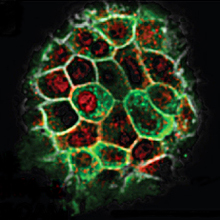Liver Stem Cells Discovered in Mice
Liver Stem Cells Discovered in Mice
Scientists successfully identified and grew a renewable population of liver stem cells for the first time, a new study reported. Tissues derived from these stem cells slightly boosted liver function when implanted into mice with a liver disorder. The findings could eventually lead to approaches that help rejuvenate damaged livers in people.

A single cell was coaxed to mature into liver cells that produce common liver proteins (green and red). Image courtesy of Huch et al., Nature.
The liver is a large, versatile organ that has many jobs, including cleansing blood and digesting food. The liver also has a unique ability to quickly regenerate and regain its original size if partially removed by surgery. Scientists have long known that stem cells that have the potential to create more liver cells must exist in the adult liver. But until now, no one had found a way to detect and cultivate liver stem cells.
An international team led by Dr. Hans Clevers at the Hubrecht Institute, The Netherlands, sought to identify and grow mouse liver stem cells. Their work was funded in part by the European Union and NIH’s National Institute of Diabetes and Digestive and Kidney Diseases (NIDDK). Results were described in Nature on February 14, 2013.
In earlier studies, Clevers and colleagues discovered that a protein called Lgr5 is found on the surface of rapidly dividing stem cells in the intestine, stomach and hair follicles. In all of these tissues, growth is prompted by signaling molecules known as Wnt proteins, which regulate expression ofLgr5 and many other genes. Wnt signaling is known to play a role in tissue regeneration, embryo development and cancer.
To see if Lgr5 might also be a marker for liver stem cells, the scientists studied genetically engineered mice in which Lgr5 genes were tagged by “reporter” genes. The researchers found that the gene was not activated in healthy mouse livers. But in injured livers, small Lgr5-positive cells appeared near the bile ducts—a location where resting liver stem cells were thought to reside. The cells also showed signs of Wnt signaling.
The researchers traced Lgr5-positive liver cells in mice after liver injury. Within a week, they detected small, fast-growing Lgr5 offspring cells, which later evolved into bile duct cells and liver cells.
To grow Lgr5-positive liver cells, the researchers used a 3-D culture system they’d previously developed for growing stem cells into tiny clumps, or “organoids.” Some of the cultures were propagated from a single Lgr5-positive cell. All were grown in a special medium that enhances Wnt signaling.
The team was able to grow and propagate the resulting liver organoids for several months. In culture, the organoids could be coaxed into generating functional liver and bile duct cells. When the organoids were injected into mutant mice with a deadly liver enzyme deficiency, patches of enzyme-producing liver cells appeared in the livers of 5 of the 15 treated mice. Mice with successful organoid transplants survived significantly longer than untreated enzyme-deficient mice.
“This study raises the hope that the human equivalent of these mouse liver stem cells can be grown in a similar way and efficiently converted into functional liver cells,” says coauthor Dr. Markus Grompe of the Oregon Health and Science University School of Medicine. Going forward, the researchers plan to test other growth factors and conditions to improve the efficiency of the procedure.
By Vicki Contie
###
* The above story is reprinted from materials provided by National Institutes of Health (NIH)
** The National Institutes of Health (NIH) , a part of the U.S. Department of Health and Human Services, is the nation’s medical research agency—making important discoveries that improve health and save lives. The National Institutes of Health is made up of 27 different components called Institutes and Centers. Each has its own specific research agenda. All but three of these components receive their funding directly from Congress, and administrate their own budgets.




















